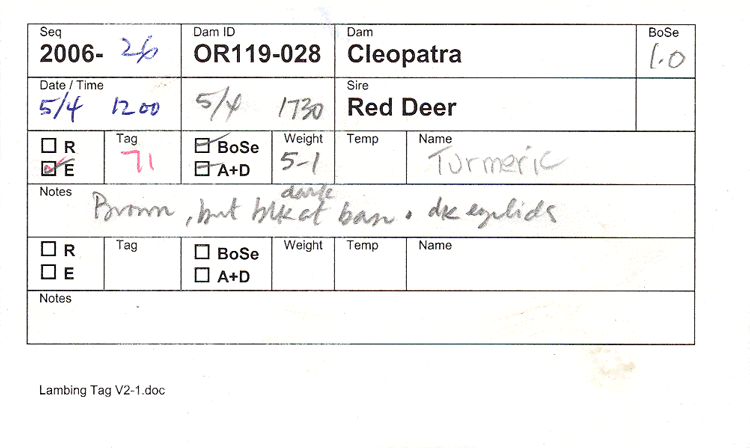Lambing Cards, the Ovine Hybrid of Baseball Cards and Scorecards
For generations before the internet replaced paper, boys happily frittered away countless hours on baseball cards, memorizing statistics and honing their negotiation skills. At the same time, if they were lucky, they were introduced by their grandfathers, as Steve was, to the insanely arcane world of scorecards, meticulously recording the details of a game with their stubby little pencils and even stubbier little fingers. No wonder Steve came up with the idea of lambing cards.
Like their baseball predecessors, lambing cards are both a luxury and a necessity. You do not need them to produce healthy, marketable Soay sheep. But once you try them, you cannot get along without them. And they are a lot easier to master than baseball scorecards.
The lambing card is nothing more than a 3 x 5 card with pre-printed information about each dam/sire breeding pair and blank spaces for the shepherd to capture the vital statistics for the ewe’s one or two lambs right after it/they arrive.
You may ask, why bother with cards, why not simply annotate a list of your Soay sheep as lambing proceeds? We once used a spreadsheet on a clipboard and it was okay, but the clipboard had a nasty habit of falling off ledges into the muck and it was a total mess by midway through lambing. Plus, finding our way across an 11-inch line of small type to be sure we record data for the correct ewe is exasperating, even if we remember to bring our reading glasses. With cards, once we know which ewe lambed, we grab her card, stick it in the Lamb Kit, and we’re set to go. Besides, it is fun to shuffle through the deck in the evenings as we chatter about lambs born and yet unborn.
Every picture still tells a story even if Rod Stewart does not, so before I get any further wound up about lambing cards, let me show you what one looks like. Here is our card for Cleopatra and her first lamb, Turmeric, in 2006:

A few notes on a few items. The first box, Seq 2006- tracks the order in which the ewes give birth. Cleopatra was our 26th ewe to lamb in 2006.
OR119-028 is Cleo’s ear tag number. We always double check the ewe’s tag once we get her in the jug with her lamb(s).
BoSe in the upper right hand corner reminds us to give the ewe her shot of selenium and vitamin E supplement, 1.5cc for big ewes, 1.0cc for gimmers.
Date/time of course records when the lamb arrived. We use the adjacent blank box to record the date and time we first work the lamb. That way, we can decide whether there’s enough of a time lag to warrant adjusting the lamb’s birth weight for a later-acquired belly-full of milk.
Tag. If you look closely at a lamb’s ears (sheep, not botanical), you know how small they are, too delicate to support a full-sized eartag. To avoid lamb mixups, we install little plastic temporary eartags on our newborns.
Notes — our catchall. Looking over the 2006 cards, it seems we cared most about fleece and whether a lamb was light or dark phase. Typical are Steve’s comments about Turmeric, roughly translated as “Brown [fleece], but dark/black at base. Dark eyelids.”
Twins. Luckily, Steve designed our card to accommodate the possibility of multiple births. Last year we needed this option for eight pairs of twins, whew!
Have I persuaded you of the benefits of lambing cards? If so, the key is to make them before lambing starts. Their utility lies in having them ready to grab and go. You can design them on the computer (Mailmerge on Microsoft Word works just fine), by hand, or on your trusty old Selectric typewriter. One size does not fit all. Your custom-designed card will mirror your operation and will include the information important to you.
Oh yes, if you happen to own a Roger Clemens rookie card you’d like to trade for a tan Soay ewe with great horns, give us a call — collect.
For now …